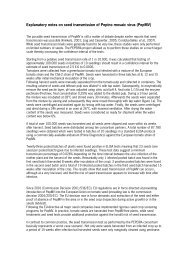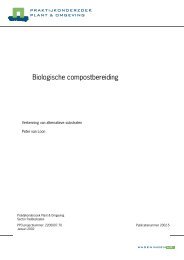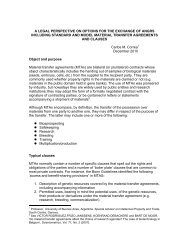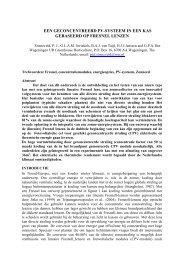Oil spill dispersant article
Oil spill dispersant article
Oil spill dispersant article
Create successful ePaper yourself
Turn your PDF publications into a flip-book with our unique Google optimized e-Paper software.
prevailing temperature, wind speed and wave<br />
conditions.<br />
The reduction in <strong>dispersant</strong> effectiveness is<br />
partly due to the increase in viscosity, but<br />
is also due to the stability of the emulsion.<br />
Some recently developed <strong>dispersant</strong>s have the<br />
capability to ‘break’ the emulsion (cause it<br />
to revert back to oil and water phases), particularly<br />
when the emulsion is freshly formed<br />
and not yet thoroughly stabilized. A double<br />
treatment of <strong>dispersant</strong>; the fi rst stage at a<br />
low treatment rate to ‘break’ the emulsion,<br />
followed after some time by second treatment<br />
at a higher rate to disperse the oil,<br />
has been found to be effective. As emulsified<br />
Alaskan with C 9527<br />
Alaskan with C 9500<br />
Grane<br />
Balder<br />
Bonny Light<br />
Aquila<br />
Oseberg- Etive<br />
Sture blend<br />
Troll<br />
6621/661179/grafisk/dispergerbarhetsgrense.eps<br />
DISPERSIBLE<br />
EASILY REDUCED<br />
POORLY<br />
DISPERSIBLE<br />
100 1000 10000 100000<br />
Viscosity (cP at 10 s-1)<br />
Examples of different viscosity limits for dispersibility of<br />
different oil types.<br />
oil undergoes further weathering, the emulsion<br />
becomes more stable and <strong>dispersant</strong>s<br />
become less effective. A methodology for<br />
“mapping” of the <strong>dispersant</strong> effi ciency as a<br />
function of the specifi c emulsion viscosity has<br />
to be established to obtain a documented<br />
foundation for the calculation of the probable<br />
“time window” for efficient <strong>dispersant</strong> application.<br />
Such studies have revealed that the emulsion<br />
viscosity limits for dispersibility might<br />
vary substantially between the different oils<br />
(see fi gure above). By combining the information<br />
from the dispersibility studies, with the<br />
weathering prediction using e.g. the SINTEF<br />
<strong>Oil</strong> Weathering Model, the operation window<br />
for the opportunity of using <strong>dispersant</strong> for the<br />
different oils can be established (see figure top<br />
right).<br />
Property: VISCOSITY OF EMULSION <strong>Oil</strong> Type: TROLL (IKU)<br />
Data Source: IKU Petroleum Research (1995)<br />
Wind Speed (m/s): 15<br />
Chemically dispersable (7000 cP)<br />
Viscosity (cP)<br />
100000<br />
10000<br />
1000<br />
100<br />
Based on lab weathering data<br />
Sea surface temperature: 13˚C<br />
10<br />
0.25 0.5 1 2 3 6 9 12 1 2 3 4 5<br />
Hours<br />
Days<br />
6621/661179/grafisk/trflvie2.eps<br />
15 m/s<br />
10 m/s<br />
5 m/s<br />
2 m/s<br />
Caculation of “time-window” for effective use of<br />
<strong>dispersant</strong>s on Troll Crude (North Sea) under various<br />
wind-/sea-state conditions<br />
Dispersant type, application<br />
method and treatment rate<br />
Although many <strong>dispersant</strong>s may be capable of<br />
meeting the minimum level of performance<br />
specifi ed in different national approval procedures,<br />
not all <strong>dispersant</strong>s are the same.<br />
It is particularly important to recognise<br />
the very large difference in performance<br />
between the older, ‘conventional’ or ‘hydrocarbon-base’<br />
<strong>dispersant</strong>s and the much more<br />
effective ‘concentrate’ <strong>dispersant</strong>s available<br />
today. ‘Hydrocarbon-base’ <strong>dispersant</strong>s are<br />
much less effective than ‘concentrate’ <strong>dispersant</strong>s,<br />
even when used at ten times the treatment<br />
rate. Even amongst the most recently<br />
developed <strong>dispersant</strong>s, there are significant<br />
differences in capability. Some <strong>dispersant</strong>s are<br />
better at dispersing some oils than other <strong>dispersant</strong>s.<br />
Specific testing will reveal the best<br />
<strong>dispersant</strong> for a particular oil and weathering<br />
state.<br />
The performance of a <strong>dispersant</strong> will depend<br />
on the prevailing sea conditions. Dispersants<br />
work well on easily disperible oils at low seastate<br />
with noe breaking waves (< 5 m/s wind),<br />
however, the dispersion prosess may go more<br />
rapid in rougher seas.. Dispersant can therefore<br />
be sprayed in very calm conditions if<br />
rougher seas are expected to occur within a<br />
few hours. The <strong>dispersant</strong> will stay with the<br />
10

















